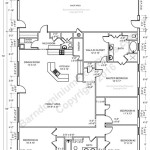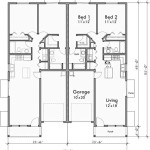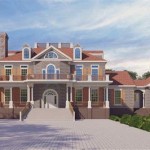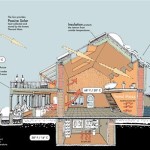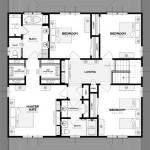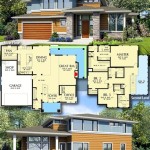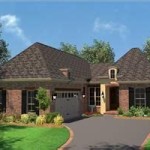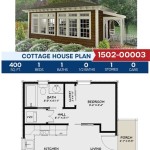L-Shaped Home Floor Plans: Design, Benefits, and Considerations
L-shaped home floor plans are a popular design choice in modern residential architecture. Their distinctive layout, characterized by two wings meeting at a right angle, offers a diverse range of benefits and design possibilities. This configuration can be adapted to suit various lot sizes, orientations, and lifestyle needs. This article will explore the key advantages of L-shaped floor plans, discuss essential design considerations, and examine common variations and applications.
Maximizing Natural Light and Outdoor Integration
One of the primary benefits of an L-shaped floor plan is its ability to maximize natural light penetration. The two wings of the house allow for increased exterior wall space, providing more opportunities for window placement. This increased window surface can facilitate better solar exposure, reducing the need for artificial lighting during the day and potentially lowering energy consumption. Furthermore, the orientation of the L-shape can be strategically planned to leverage prevailing winds for natural ventilation, further enhancing energy efficiency and indoor air quality.
The L-shape also naturally creates a sheltered outdoor space, often referred to as an "outdoor room" or courtyard. This area can function as a private patio, garden, or entertainment zone. The walls of the house provide protection from wind and noise, creating a more comfortable and usable outdoor environment. The integration of indoor and outdoor living spaces can be further enhanced through the use of sliding glass doors or large windows that blur the boundaries between the interior and exterior. This design approach not only expands the usable living area but also fosters a connection with nature, contributing to a sense of well-being.
Consider the placement of the primary living areas within the L-shape. Orienting the living room and dining area towards the courtyard can maximize the enjoyment of the outdoor space. Similarly, placing bedrooms along the less sun-exposed wing of the house can help maintain cooler temperatures during the hotter months. Careful planning of the L-shape orientation based on the local climate and site conditions is crucial for optimizing natural light and ventilation.
Defining Zones and Enhancing Privacy
The L-shaped floor plan naturally lends itself to the creation of distinct zones within the home. The two wings of the house can be used to separate different functions, such as living areas, sleeping quarters, and service areas. This zoning can enhance privacy and reduce noise transmission between different parts of the house. For example, one wing might house the master suite and guest bedrooms, while the other wing contains the kitchen, living room, and dining area. This separation creates a clear distinction between private and public spaces, which can be particularly beneficial in households with multiple occupants or those who frequently entertain guests.
Furthermore, the L-shape can be used to create a visual and physical separation between the main house and an attached garage or secondary dwelling unit (ADU). This can be achieved by positioning the garage or ADU along one of the wings, creating a buffer between the main living areas and the garage or the secondary dwelling. This arrangement enhances privacy and reduces noise transmission from the garage or ADU into the main house.
Within each wing, further zoning can be implemented to delineate specific functions. For instance, within the sleeping quarters wing, bedrooms can be grouped together, and a separate bathroom and walk-in closet can be integrated to form a private suite. In the living areas wing, the kitchen can be designed as an open-plan space that flows seamlessly into the dining area and living room, creating a social and interactive hub for the family.
Adaptability to Different Sites and Styles
L-shaped floor plans are highly adaptable to a variety of site conditions and architectural styles. Their flexibility allows them to be adapted to fit irregular lot shapes, sloping terrain, and specific site orientations. The L-shape can be oriented to maximize views, avoid undesirable site features, or capture prevailing winds. This adaptability makes them a popular choice for both urban and rural settings.
On narrow or long lots, the L-shape can be oriented along the length of the lot, maximizing the available space and creating a sense of spaciousness. On corner lots, the L-shape can be positioned to take advantage of the increased street frontage, creating a prominent and visually appealing facade. On sloping sites, the L-shape can be stepped to follow the contours of the land, minimizing excavation and creating a multi-level design that maximizes views and natural light.
L-shaped floor plans can be incorporated into a wide range of architectural styles, from traditional to contemporary. In traditional styles, the L-shape can be used to create a symmetrical and balanced facade, while in contemporary styles, it can be used to create a more asymmetrical and dynamic design. The L-shape can also be adapted to incorporate various architectural features, such as porches, balconies, and roof overhangs, adding character and visual interest to the exterior.
The orientation of the L-shape relative to the street is also a critical consideration. In some cases, positioning the L-shape with the "open" side facing the street can create a welcoming and inviting entrance. In other cases, orienting the L-shape with the "closed" side facing the street can provide increased privacy and security. The optimal orientation will depend on the specific site conditions, the desired level of privacy, and the overall architectural style of the house.
Furthermore, the L-shape can be mirrored or rotated to adapt to different site constraints or design preferences. A mirrored L-shape can be used to create a symmetrical layout or to accommodate specific site features. A rotated L-shape can be used to optimize solar orientation or to maximize views. The ability to manipulate the L-shape in different ways provides designers with a great deal of flexibility in creating a custom home that meets the specific needs of the client.
Design Considerations for L-Shaped Homes
While L-shaped homes offer numerous advantages, careful consideration must be given to certain design aspects to ensure optimal functionality and aesthetic appeal. Circulation is a key consideration. The junction where the two wings meet can become a potential bottleneck if not properly planned. Ensuring clear and efficient pathways between different areas of the house is critical for comfortable living. Corridors should be wide enough to accommodate traffic flow, and strategically placed doorways can help to direct movement through the space.
Acoustics should also be factored into the design, particularly in areas where noise transmission is a concern. The L-shape can create echo chambers if not properly treated. Soundproofing materials, such as insulated walls, double-paned windows, and soft flooring, can help to reduce noise levels and create a more peaceful living environment. Consider the placement of noisy appliances, such as washing machines and dishwashers, away from bedrooms and living areas.
Finally, landscaping plays a crucial role in enhancing the beauty and functionality of an L-shaped home. The courtyard created by the L-shape can be transformed into a lush garden, a relaxing patio, or an outdoor entertainment area. Strategic planting of trees and shrubs can provide shade, privacy, and visual interest. Hardscaping elements, such as walkways, patios, and retaining walls, can further define the outdoor space and create a cohesive connection between the interior and exterior of the house. The courtyard can be designed to complement the architectural style of the house, creating a unified and harmonious design.
Accessibility is another significant factor. Ensure the design incorporates universal design principles, particularly if the home is intended for aging in place or for individuals with mobility limitations. Wide doorways, level thresholds, and accessible bathrooms are essential features to consider. Ramps or elevators may be necessary to navigate between different levels of the house. Thoughtful planning of accessibility features can ensure that the home is comfortable and usable for everyone.
Building codes and regulations should also be carefully reviewed. Local zoning ordinances may impose restrictions on the size, height, and setback requirements of the house. It is important to ensure that the design complies with all applicable building codes and regulations before starting construction. Working with a qualified architect or builder can help to navigate the complex regulatory landscape and ensure that the project is completed safely and legally.
The overall cost of construction should also be considered. L-shaped homes can be more expensive to build than simpler rectangular homes due to the increased complexity of the design and the increased amount of exterior wall surface. It is important to develop a realistic budget and to obtain accurate cost estimates from contractors before starting construction. Value engineering techniques can be used to reduce costs without compromising the quality or functionality of the design. Consider using cost-effective materials, simplifying the roof design, and minimizing the amount of excavation required.
Sustainability should be a guiding principle throughout the design process. Incorporating sustainable design features can reduce the environmental impact of the house and lower energy costs. Consider using energy-efficient appliances, installing solar panels, and using recycled or locally sourced materials. Implementing water conservation measures, such as rainwater harvesting and low-flow fixtures, can also reduce water consumption. A well-designed and sustainable L-shaped home can be both beautiful and environmentally responsible.

Best Of L Shaped Ranch House Plans New Home Design

Farmhouse Style House Plan 4 Beds Baths 3465 Sq Ft 531 2

L Shaped House Plan 3 Bedroom Design For Narrow Lots

Contemporary Style House Plan 1447

L Shaped House Plan With Upstairs Family Room Kitchenette And Home Office 777053mtl Architectural Designs Plans

L Shaped House Plans With Side Garages Blog Eplans Com

Why An L Shaped House Plan Makes The Best Home Design Monster Plans Blog

L Shaped Home Courtyard Villa Resort Style House Plan Room

L Shaped House Plans With Side Garages Blog Eplans Com

Small Modern L Shaped 2 Bedroom Ranch House Plan 1632

